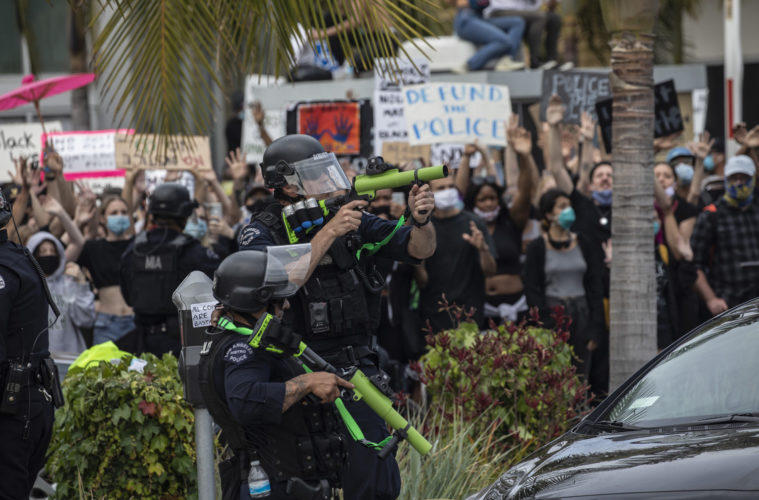A broken taillight almost cost Darrick Rainey his life.
In this week’s episode of the L.A. Weekly podcast, Editor-In-Chief Darrick Rainey and photojournalist Ted Soqui sit down with Publisher Brian Calle to discuss how police brutality and protesting have affected them on a personal level.
It was the 80s. Darrick was leaving work after a long day at the office. Although traffic was at its typical L.A. standstill, he saw two motorcycle traffic cops behind him, indicating he pull over. As he rolled down his window, Darrick immediately felt the unforgiving metal of a police gun press harshly against his head.
“He pushed the gun through the window and pressed it against my head, telling me, ‘this is not the fucking movies, get out of the car.’ Which to this day, I have no idea what that means,” recollects Darrick.
The traffic stop, which was quickly becoming a much larger incident, was happening directly in front of his office, in full view of his coworkers, bosses and everyone waiting in their cars.
Before he knew it, support police rushed over, parking their cars haphazardly on the sidewalk. Multiple police began to approach him with nightsticks. As a young black man being raised in America, Darrick knew exactly what that meant for him.
“I remember yelling ‘wow, you guys are going to beat me over a broken taillight?’ Which I think to this day, I think that saved my life,” he says somberly. “If I hadn’t said that, I wouldn’t be talking to you right now.”
What happened next was all too telling of the men’s intent.
“The minute I said that, I think the officers realized they had a huge audience of standstill traffic. The next thing that happened was amazing: everyone got into their cars and left,” he tells. “The officer that had the gun pressed to my head handed my license back and acted really nervous.”
Darrick was shaken and incredulous. “They all just left. I didn’t even get a warning ticket, any warning, they just left.”
Darrick’s story is a disturbing drop in a sea of countless instances of ongoing police overstep, brutality and force in black America. While Darrick’s quick thinking and brave voice may have indeed saved his life that day, many others have not been so lucky.
“Most black men, black kids, and people of color have had these experiences,” Darrick tells Brian and Ted. “A lot of people have had these experiences. I will say I was lucky enough to grow up in Hollywood, but I still had negative experiences. Especially in my 20s.”
Darrick was pulled over twice in his twenties. Once for the deadly crime of a burned out tail bulb. The second? Racial profiling.
“The second instance where I was pulled over, I was on the way home down Melrose with my girlfriend after a very nice dinner. I was pulled over by a bunch of undercover Hollywood vice types, and I again had a gun pointed to my forehead,” he remembers. “They claimed they were looking for two black men suspects who had robbed a restaurant. I was obviously with a woman on the way home. So yeah, I’ve been through these experiences in one way or another. The first experience you never forget.”
Ted Soqui is an L.A. Weekly photojournalist with a long history of chronicling protests, riots, and other social tipping points throughout Los Angeles. Ted was there, on Friday, May 29 as protesters stopped traffic, and experienced the brutality of authority first-hand.
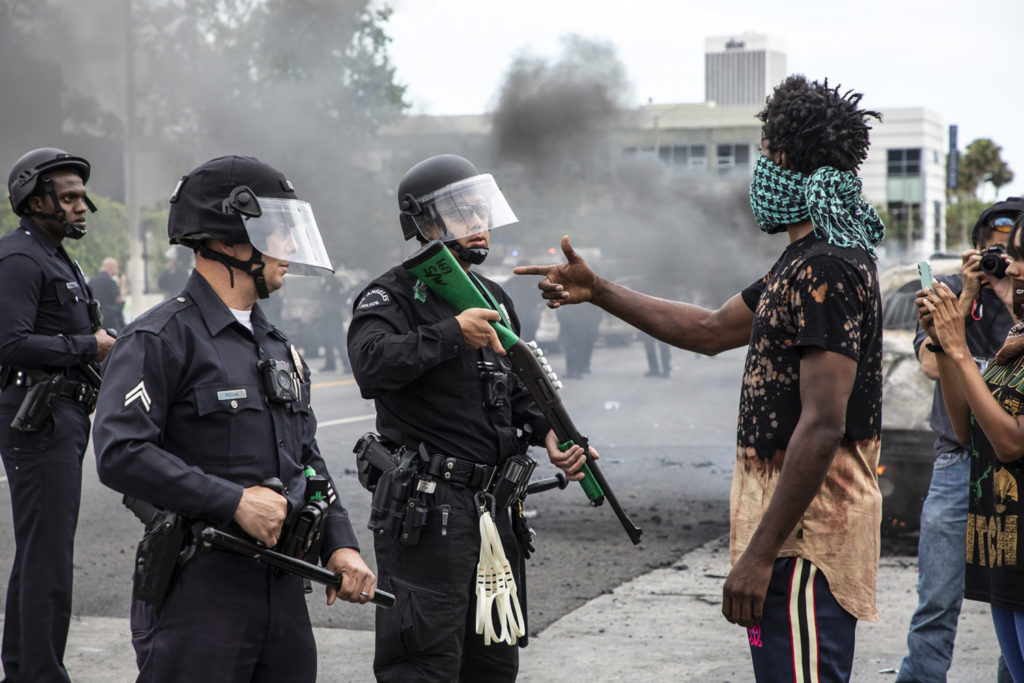
Protesting and rioting in the Fairfax district of Los Angeles.
5/30/2020 Los Angeles
(Photo by Ted Soqui)
“The demonstrators took over the 110 freeway in downtown,” recollects Ted. “The CHP and the LAPD attempted to clear the demonstrators…it was a cat and mouse situation.”
Ted focused his camera on the officers standing above the freeway on an overpass, positioned with rubber bullet cannons aimed at the crowds below. That’s when he noticed an officer had a cannon aimed right at him.
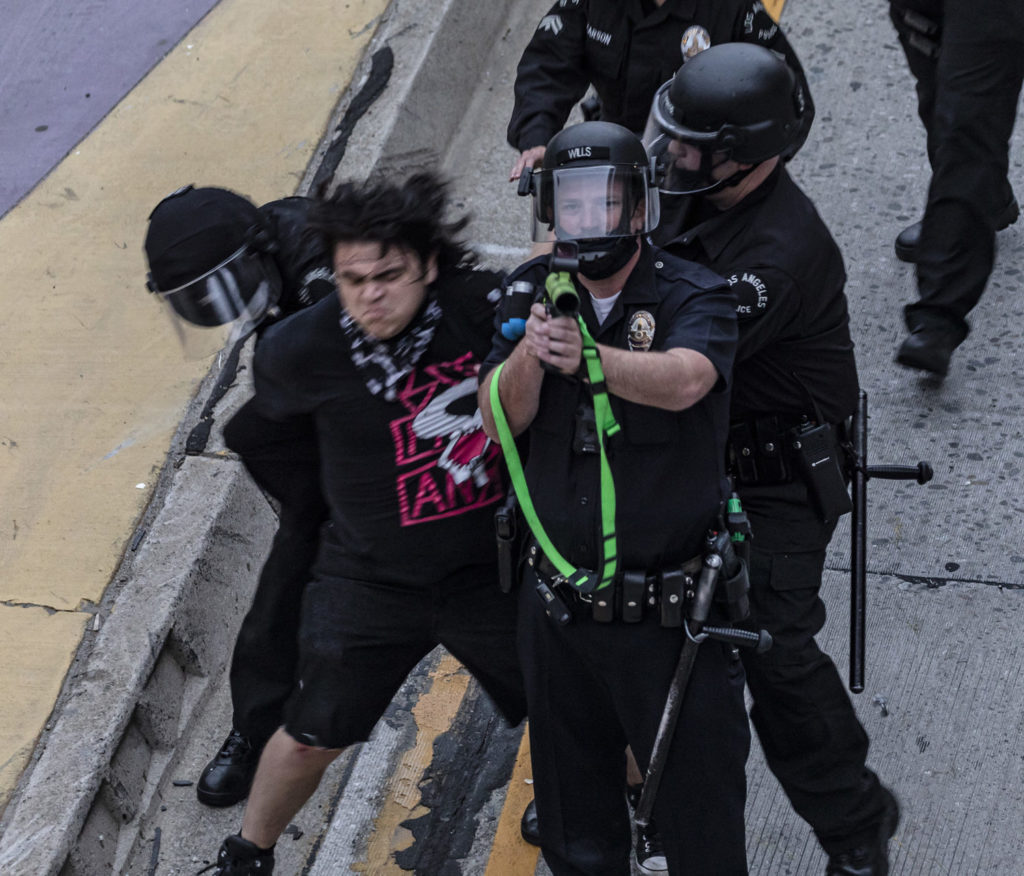
Demonstrators in downtown Los Angeles take over the 110 freeway and damage several businesses in the area.
5/29/2020 Downtown Los Angeles
(Photo by Ted Soqui)
“I moved left … I moved right, and realized that he was definitely tracking me,” says Ted. “In that situation I could either duck or I could take his picture. I decided I’m at least going to get a photograph of this guy who is going to shoot me.”
What he didn’t notice was the law enforcement with guns modified to shoot pellets of pepper spray. When you’re hit, the insidious spray disperses, rendering you painfully distracted.
“I got coated in pepper spray,” shares Ted. “I think they knew I was a journalist.”
Ted is no stranger to the hazards of documenting civil unrest. From the riots of ’92 to today, what he is experiencing in the field at this moment is unlike anything he’s ever seen.
“I’ve never seen them deploy teargas or pepper spray and rubber bullets in such numbers,” Ted amazes. “I’ve gotten reports from fellow colleagues that were attacked, blindsided and beaten. It sounds very familiar from what happened in 1992.”
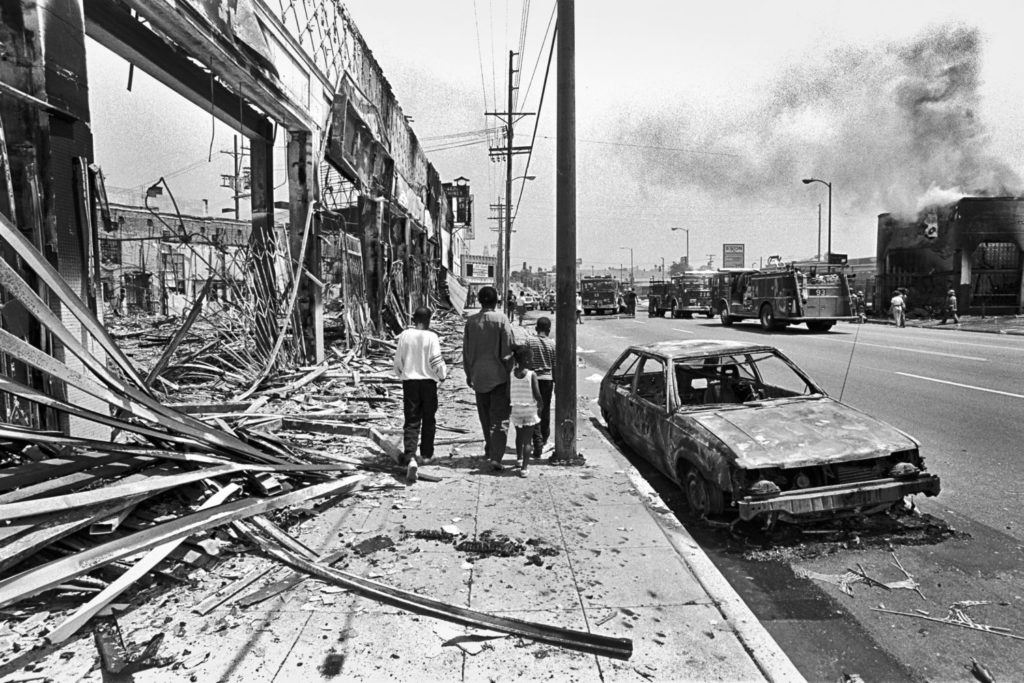
Children walk past a burned down building on Adams Blvd. near Crenshaw Ave, following the 1992 L.A. riots. (Photo by Ted Soqui)
Tricks of the trade have helped our photojournalist get out of dangerous situations in the past. For the current protests, things are a little different. Anxiety over COVID-19 and reports of law enforcement attacking and arresting the press made him change his methods of getting information out to the people.
He got a tip that looters were on Melrose. Before he could race to the scene, he had to strategize his method of transportation.
“I didn’t want to drive my car because in 1992 I drove my car around taking photos and I nearly lost it to people attempting to turn it over and set it on fire,” he explains. “So this time I parked two miles away and rented the bane of existence, an electric scooter.”
Annoying as they are, that scooter ended up potentially saving his life.
“I parked in front of a store that was being looted and I waited for someone to go in. I started to take their photo and they started to yell at me.”
Ted attempted to ignore them, and they began to threaten him.
“I took their picture and they all dropped their loot and started to chase me,” he says. “I hit the scooter, heard them chasing me, and just took off.”
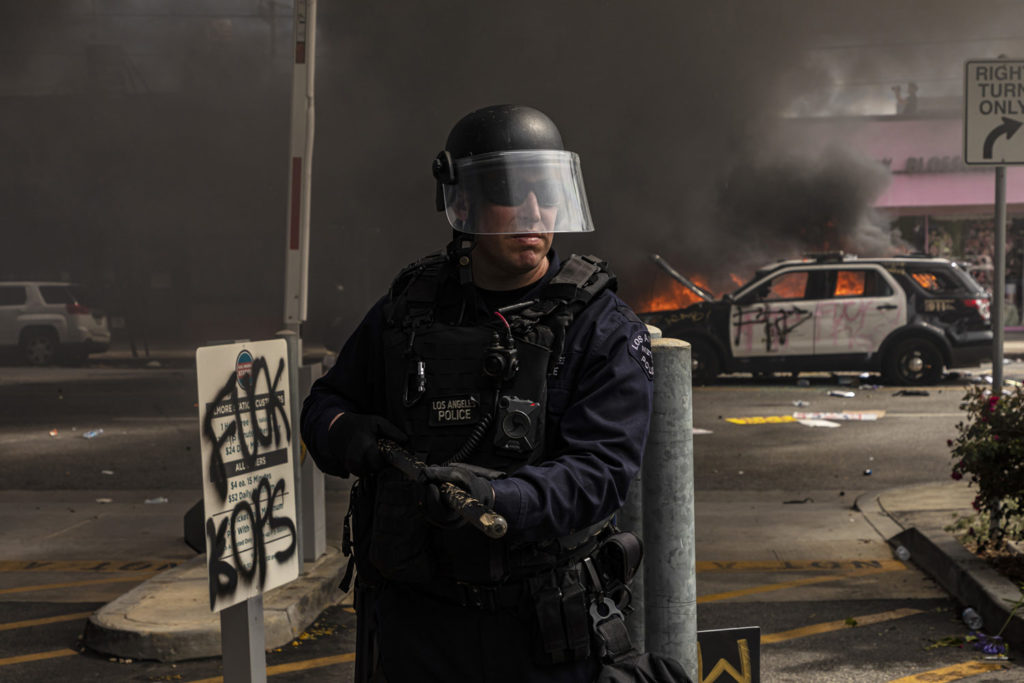
Protesting and rioting in the Fairfax district of Los Angeles.
5/30/2020 Los Angeles
(Photo by Ted Soqui)
Photographers like Ted are vital to movements like the one we are witnessing today. Not only does he allow for information to be spread, ensuring truths are not ignored, but his presence and the permanent memory of his lens helps to deter the agitators who take away from the important and meaningful work of the protesters.
As someone on the front lines, he has bore witness to the realities of this revolution.
“I think if the police were less heavy handed, agitation wouldn’t have been the spark this time,” he shares. “I’ve been to probably a million protests. Usually you have agitators, but if you don’t have a police line, a skirmish line ready to battle, the battle doesn’t happen.”
Battles like what happened on that L.A. freeway.
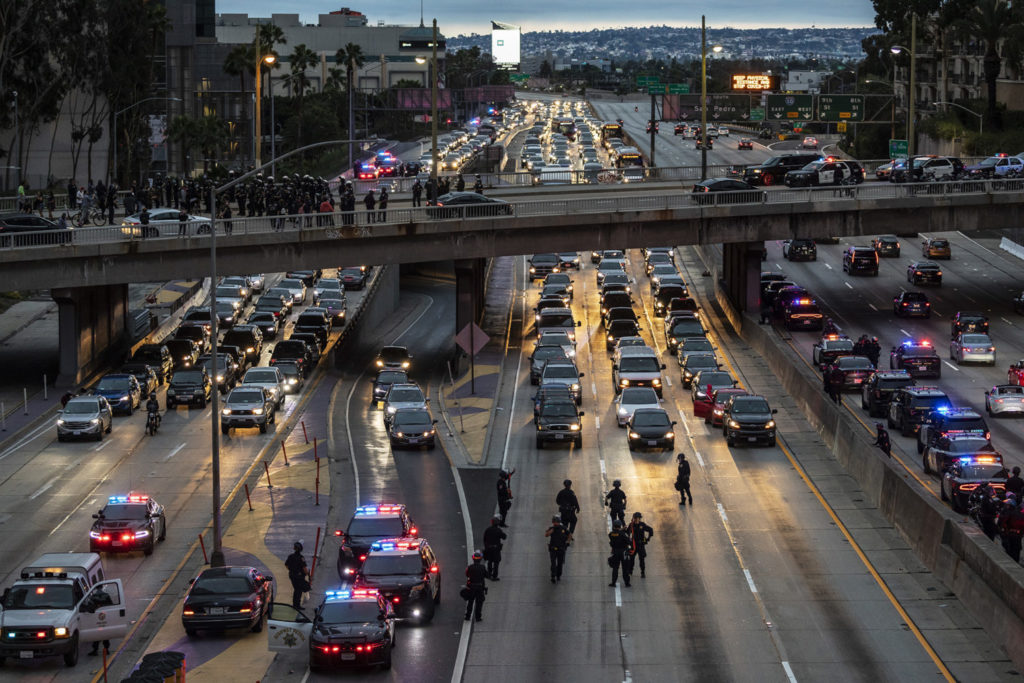
Demonstrators in downtown Los Angeles take over the 110 freeway and damage several businesses in the area.
5/29/2020 Downtown Los Angeles
(Photo by Ted Soqui)
“The protest was peaceful,” tells Ted. “I think the tactics of police need to be looked at for these situations.”
It would seem that until there is a resolution, the people will not back down, despite the violence and aggression they are being confronted with.
“It’s incredible what’s happened, as far as worldwide with these protests,” marvels Darrick. “And nationwide.”
As Brian was told as a young columnist with the O.C. Register, it is virtually impossible to get a conviction against a police officer. Hopefully, with the unrelenting bravery of the movement that fills our streets today, that’ll change.
We can start that change by learning, listening and using our platforms to tell the stories of people like George Floyd, Breonna Taylor and Ahmaud Arbery.
As Brian says, “If there is one podcast I’d want people to listen to, it’s this one.”
Listen to this week’s podcast here or find it on iTunes here.
Advertising disclosure: We may receive compensation for some of the links in our stories. Thank you for supporting LA Weekly and our advertisers.

